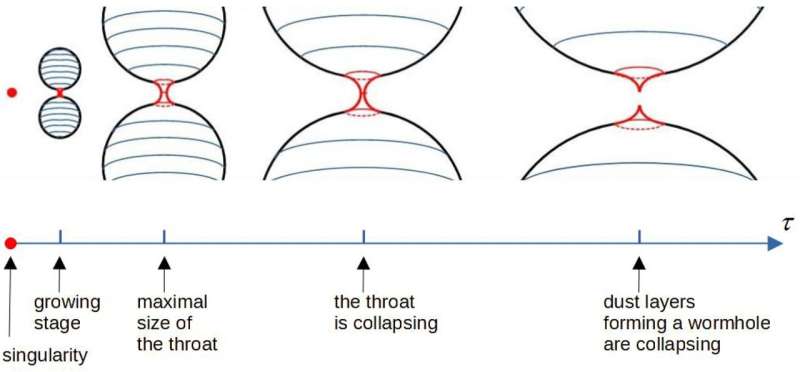This article has been reviewed according to Science X's editorial process and policies. Editors have highlighted the following attributes while ensuring the content's credibility:
fact-checked
trusted source
proofread
Astrophysicists offer theoretical proof of traversable wormholes in the expanding universe

The expansion of the universe at some stage of evolution is well described by the Friedmann model. It was derived from general relativity a hundred years ago, but it is still considered one of the most important and relevant cosmological models.
RUDN University astrophysicists have now proven the theoretical possibility of the existence of traversable wormholes in the Friedmann universe. The research is published in the journal Universe.
"A wormhole is a type of highly curved geometry. It resembles a tunnel either between distant regions of the same universe or between different universes. Such structures were first discussed in the framework of solutions to the gravitational field equations a hundred years ago. But the wormholes considered then turned out to be non-traversable even for photons—they could not move from one 'end of the tunnel' to the other, not to mention going back," said Kirill Bronnikov, doctor of physical and mathematical sciences, professor of RUDN University.
"Others are now being considered—traversable wormholes in various theories of gravity and the presence of various types of matter. We investigated possible traversable wormholes in the general theory of relativity, which are supported by dustlike matter," Bronnikov added.
The astrophysicists investigated a generalized form of the famous Lemaître–Tolman–Bondi solution, which describes the evolution of spherically symmetric distributions of electrically neutral dust in general relativity. The researchers generalized it to the case of when there is an external source of an electric or magnetic field and a non-zero cosmological constant. They aimed to find mathematical conditions under which traversable wormholes could exist in such a setting, and then give a cosmological explanation for this.
The researchers obtained numerical solutions that describe the movement of photons through wormholes connecting different Friedmann universes or different parts of the same universe. Whether it will be possible to pass through a wormhole depends on the parameters of its "entrance" and the initial conditions. The physicists generalized the case of one universe to the case of multiple universes. In this case, the "mother" universe has several "entrances" to wormholes that connect it with the "daughter" universe.
"A charge on one 'pole' inevitably leads to an opposite charge on the other. At this other pole there might be a similar wormhole mouth, and beyond that another universe, and so on. The whole picture will resemble churchkhela, a wonderful Georgian dessert. Some of the wormholes can connect different parts of the same universe," Bronnikov explained.
"Possible observational signs of such objects, in particular, the properties of the cosmic microwave background and magnetic fields, may be the subject of further research. It is especially interesting to compare the characteristics of our wormhole models with the observed parameters of cosmic voids and other inhomogeneities in our universe," Bronnikov concluded.
More information: Kirill A. Bronnikov et al, Possible Wormholes in a Friedmann Universe, Universe (2023). DOI: 10.3390/universe9110465
Provided by RUDN University




















